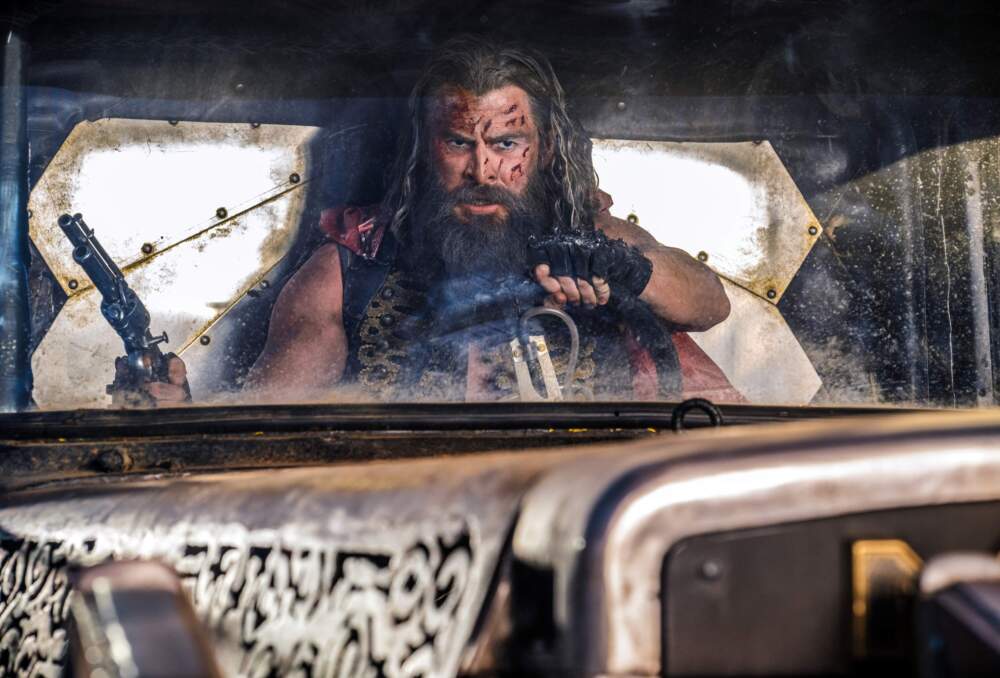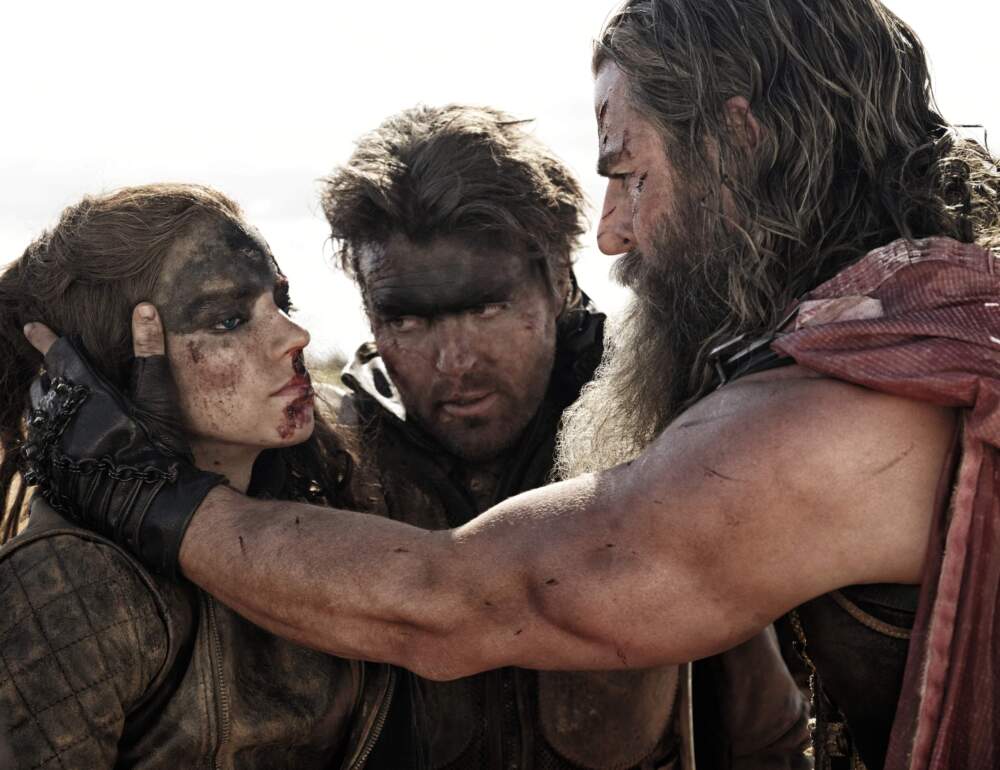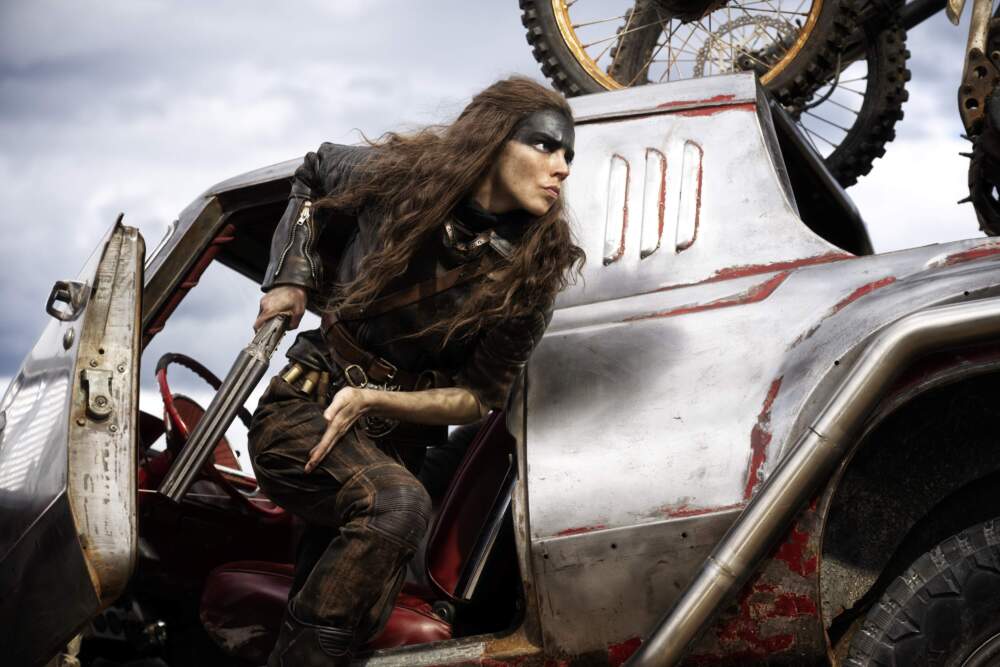Advertisement
Review
'Furiosa: A Mad Max Saga' is stranger and more sorrowful than its predecessor

Twenty-six years ago, director George Miller alienated audiences with a staggeringly expensive sequel so weird and frightening that the head of Universal Pictures was forced to resign in the wake of its disastrous reception. “Babe: Pig in the City” is one of the funniest flexes a filmmaker ever pulled off, following the gentle, pastoral Best Picture nominee “Babe” — about an adorable talking pig who thinks she’s a sheepdog — with a phantasmagoric romp through a mythical metropolis, providing children with scary, Orwellian lessons about incipient fascism and traumatic vehicular chases more suited to one of the director’s “Mad Max” movies. (The cute little porker even winds up wearing a spiked leather dog collar.) Terrified kids were fleeing the auditorium in tears at the matinee my sister and I attended, the two of us gasping in disbelief and kicking up our heels in delight. “Babe: Pig in the City” was a masterpiece, but not the movie anybody was expecting. It lost so much money it nearly bankrupted the studio. Critic Gene Siskel named it the best film of the year.
So let it never be said that George Miller panders to fans looking for more of the same. Alas, “Furiosa: A Mad Max Saga” is not a masterpiece, and I don’t think it’s the movie anybody is expecting. Miller’s hotly anticipated prequel to his triumphant 2015 “Mad Max: Fury Road” is a much stranger, more sorrowful picture than its predecessor, replacing that installment’s high-octane excitement with moodier meditations on scarcity and loss at the end of the world. It’s a very good, sometimes shatteringly powerful film that has the misfortune of following one of the greatest movies ever made. (My friend, the brilliant critic Bilge Ebiri, calls “Fury Road” the Sistine Chapel of action filmmaking. I’ve watched it at least a dozen times.)
Miller has taken distinctly different stylistic approaches to each of his five “Mad Max” pictures — it’s the only series I know of where the world ends between the first and second films — and “Furiosa” feels a bit like when the bare bones of “The Road Warrior” filled out into the more digressive worldbuilding of “Mad Max Beyond Thunderdome.” The compressed, breakneck “Fury Road” was, for all intents and purposes, a feature-length chase sequence, whereas “Furiosa” is a sprawling, 148-minute picaresque split into five chapters spanning 20 years in the life of the title character. It’s far more literary in spirit than the other “Mad Max” movies, like if Charles Dickens wrote a post-apocalyptic orphan novel with characters named Pissboy and Scrotus.

Before she grew up to be Charlize Theron’s bald, robot-armed badass from “Fury Road,” our Furiosa was a child (wide-eyed Alyla Browne) plucked from the Green Place of Many Mothers, a verdant, all-female Eden hidden away in a secret corner of an otherwise barren wasteland. She’s kept as a caged plaything for Dementus, a blowhard warlord played by a nearly unrecognizable Chris Hemsworth wearing a pointy putty nose. He rides a chariot pulled by Harley-Davidsons and carries himself with comical self-regard that’s undercut by a vicious sadism. Dementus forces the child to watch while her mother is crucified on a tree, an act she’ll spend the rest of the movie attempting to avenge.
The film’s five chapters follow Furiosa through different desert fiefdoms and various disguises, the Dickensian urchin working her way up to a final reckoning with the man who took everything from her. In the meantime, we’re (re)introduced to characters from “Fury Road” like the water-hoarding dictator Immortan Joe and his numbskull sons Rictus and Scrotus (or as I’ve been referring to them, Eric and Don Jr.). The film ticks off all the required prequel boxes, showing us how Furiosa lost her arm and learned how to drive a war rig, doing an entertaining and at times thrilling job of answering questions I don’t remember anybody asking.
Miller and co-writer Nick Lathouris came up with “Furiosa” during the nearly two decades it took to get “Fury Road” in front of cameras. What started as a character backstory sketch blossomed into a full-length screenplay, one they toyed with the idea of shooting before or concurrently with the 2015 picture. There was even some serious talk about doing it as an anime, which is funny when you consider how star Anya Taylor-Joy already kind of looks like an anime character come to life.
Advertisement

Taylor-Joy takes over the role of Furiosa about an hour into the movie, and her haunted, saucer-eyed stare all but burns through the screen. She’s not a close physical match for the Amazonian Theron, but they both studied ballet and have similarly lithe, catlike ways of moving through danger. After the first couple of chapters frustrate in their stop-and-go rhythms, “Furiosa” finds its groove when Taylor-Joy becomes apprentice to long-haul war rig driver Praetorian Jack (Tom Burke) building a wordless rapport that feels familiar in the most welcome ways. It is here Miller at last indulges in the automotive mayhem that made him a movie legend, as paragliding bandits with giant fans strapped to their backs swarm a speeding “guzzoline” tanker, shiny and chrome.
Everything looks cleaner and newer in “Furiosa.” In part, I suppose, because it’s a prequel, but also because the picture relies so heavily on CGI to conjure Miller’s rusted metal world of wonders. One of the things that made “Fury Road” such a miracle was that they actually built that massive fleet of crazy vehicles and crashed them all into each other out in the middle of the Namibian desert. You can read the tell-all book that was written about the arduous, years-long production (“Blood, Sweat and Chrome” by Kyle Buchanan) or you could just refer to director Steven Soderbergh’s words after seeing the final product: “I don’t understand how they’re not still shooting that film and I don’t understand how hundreds of people aren’t dead.”
“Fury Road” was one of the rare movies that really made you feel how much everything weighed. But there’s an uncanny, slightly cartoony lightness to the less tactile action sequences in “Furiosa,” presumably due to the more conventional (re: not insane) mode of production. The scalding hot color grading leans into the artifice, and I settled into the picture more easily once I started watching it like one would an anime. It gets better whenever Miller pushes things into dreamy abstraction. “Furiosa” is a movie of bold, searing images, like a silhouetted severed arm dangling from shackles against a fiery, sunset sky or a pale, dead child awash in a cargo bin full of rotting cabbage.

“As the world falls around us, how must we brave its cruelties?” asks The History Man, a face-tattooed keeper of legend who could just as well have walked out of Miller’s 2022 fantasia “Three Thousand Years of Longing.” There’s a mournfulness to the movie that wasn’t so prominent in previous entries, probably because putting an innocent young woman in these situations feels different than flinging Mel Gibson around a desert highway. And there’s the rub, isn’t it? All the excitement can’t quite compensate for the fact that this is ultimately a film about a little girl being kidnapped and enduring unspeakable horrors, with a catharsis that will come a ways down the (fury) road. That’s the problem with prequels. “Furiosa” must, by design, end on a downbeat, presaging a triumph that will happen later in a picture we’ve already seen.
Here’s where I have to admit the impact of the ending was hampered for me. At our advance screening, the AMC Assembly Row brought the house lights up to full brightness during the film’s emotional climax and left them on for the last five or six minutes of the movie. I’m told this was most likely the result of a faulty cue in the theater chain’s automated system, which is why local audiences should be glad that “Furiosa” is also playing at the Somerville Theatre and at the Coolidge Corner Theatre, independent venues where actual human projectionists are paid to make sure stuff like this doesn't happen.
Still, I was intrigued by what I could glean of those final moments, in which Miller begins to question the futility of vengeance, depicting the mindset as a desert wasteland where nothing can grow. How do you take all that hatred and rage and turn it into something hopeful? Furiosa’s solution is a corker, and I feel like this is one of those movies that might be better appreciated upon second viewing — preferably with the lights off — when one can set aside outsized expectations and embrace this odd film for what it is: a question that’s answered by “Fury Road.”
“Furiosa: A Mad Max Saga” is now in theaters.
